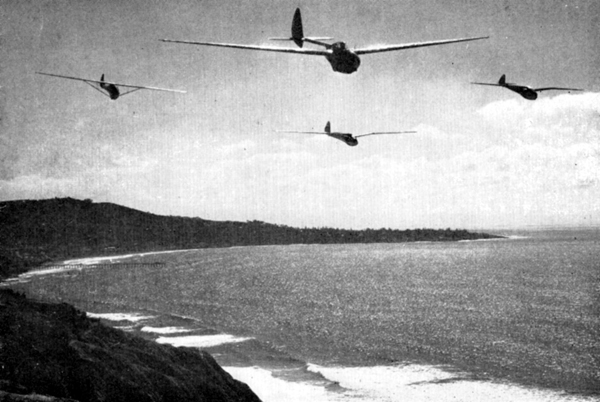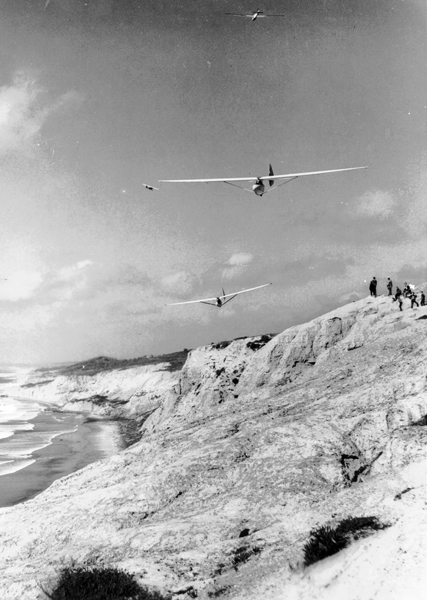|
Torrey Pines Gliderport
By Gary Fogel
Historian, Associated Glider Clubs of Southern California
San Diego has a rich history of aviation, dating back to John Montgomery's first attempts at gliding in the 1880s at Otay Mesa. Gliding has continued to be a central component of the aviation culture in San Diego since those early years. A key historic feature of that culture is the Torrey Pines Gliderport in La Jolla.
The first recorded use of the lift at Torrey Pines by a glider pilot was made on February 24, 1930. On that day, Col. Charles Lindbergh was launched in a large Bowlus sailplane from the top of Mt. Soledad towards the north. He realized that the prevailing sea breeze hitting the cliffs and Torrey Pines would provide ridge lift for his motorless plane and he continued to the north, floating above the 300 ft high cliffs, to an eventual landing on the beach near Del Mar. With this flight, Lindbergh established a regional distance record for gliders. Perhaps it wasn't the same as crossing the Atlantic in the Spirit of St. Louis, but for glider enthusiasts, a motorless flight of over 7 miles was quite a significant accomplishment.

Typical scene at Torrey Pines just after World War II showing two Bowlus Baby Albatross sailplanes soaring above the cliffs. Photo courtesy Gary Fogel

Four gliders in formation at a 1948 glider meet with La Jolla in the background. Photo courtesy Gary Fogel
|
Torrey Pines rapidly developed into a gliderport during the 1930s. Runways were graded, a club house was built and aviators from all over San Diego enjoyed cruising effortlessly on the free energy provided by the wind. Many of these local aviators were students (or recent graduates) of San Diego High School including David Robertson, Henry Severin, and more notably John Robinson, who through his skill and training at Torrey Pines, became the first pilot in the world to receive the "Diamond C" badge, the highest award for accomplishment in soaring. Robinson was also the first three-time national champion in soaring and set numerous national and world records for distance and altitude in gliders.
These any many other technological achievements and inventions related to gliding are recognized through the listing of this gliderport as a National Soaring Landmark of the National Soaring Museum (Elmira, NY), a Model Aviation Landmark of the Academy of Model Aeronautics (Muncie, IN), a San Diego City Historic Site, and its listing on the California and National Registers of Historic Places. The site is currently threatened by development, specifically by buildings directly to the east of the gliderport runway on property owned by the University of California, San Diego. A 14-story dormitory complex is currently being built directly in the landing path for gliders. The San Diego Consortium for Regenerative Medicine has identified the eastern end of the gliderport property (within the boundary of the National Register property) as the location for its new stem cell research facility. Plans for an additional multi-story dormitory have just recently been announced. While it remains possible that a compromise can be achieved that allows science to continue while preserving sailplane operations at the gliderport, the long-term continued use of this facility is in considerable jeopardy. The users of the gliderport have spoken in a unified voice in favor of stem cell research, but either 1) not at this location or 2) as part of a compromise that preserves and protects this gliding history for future generations. Save Our Heritage Organisation has a long-standing interest in this site and we look forward to SOHO's continued assistance.
Dr. Gary Fogel has written extensively on the history of gliding in San Diego, and was a co-author of the original nominations to establish the Torrey Pines Gliderport as a National Landmark of Soaring, a Model Aviation Landmark, City of San Diego Historic Site #315, and its listing on the California and National Register of Historic Places.
|
MORE FROM THIS ISSUE
From the Editor
2008 Most Endangered List of Historic Resources
Character Matters
Smart Growth - or is it?
The Impact of Historic Districts
Washington Didn't Sleep Here
How to Research Your House
Preserving Community Character
Behind the Tuscany Craze
2008 People In Preservation Award Winners
Preservation Community
Reflections
Annual Financial Report
Book Review - Working Windows
Sherlock Homes
Speakers Bureau Forming
Lost San Diego
Strength in Numbers
Advertisements
DOWNLOAD full magazine as pdf (16mb)
|





